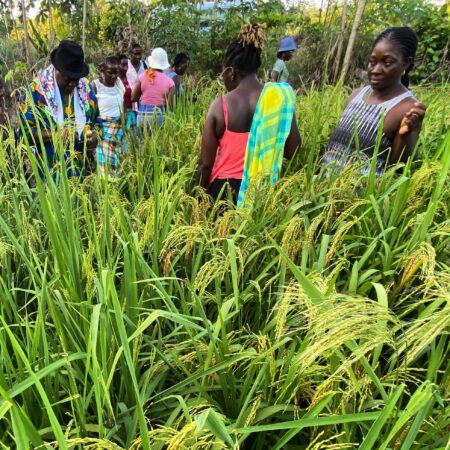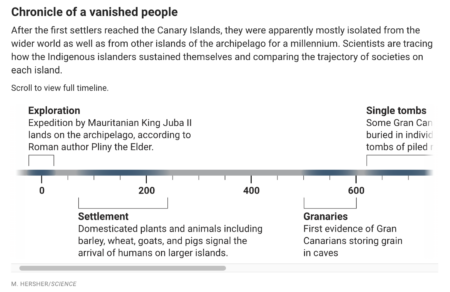Really attentive long-time readers may remember us posting a video of an interview with Edith Adjako, a Surinamese woman of Maroon descent, recorded by ethnobotanist Dr Tinde van Andel. Dr van Andel and her colleagues have been studying Maroon agriculture and how it relates to African practices. Recall that the Maroons are the descendants of enslaved people who escaped captivity during colonial times and established communities in the interior of places like Suriname which survive to this day.
Well, as it happens, my colleagues and I recently checked out a project the Crop Trust is supporting in Suriname that involves the regeneration and safety duplication in the Svalbard Global Seed Vault of Maroon rice varieties. The project is coordinated by ADRON, the national rice research institute, but is a collaboration with Maroon communities, as well as with Dr van Andel’s institute. It has now been written up in The Guardian, no less.
Here you see farmers from the Saramaccan community visiting a demonstration plot of some 75 local rice varieties one of them established under the project.

And here’s a selection of recent papers on Maroon agriculture:
- The ‘Botanical Gardens of the Dispossessed’ revisited: richness and significance of Old World crops grown by Suriname Maroons. “Spending time in the capital during childbirth or illness resulted in the loss of typical Maroon crops (e.g., Bambara groundnut), as seeds lost viability during the farmer’s absence. Motivation to grow specific crops and cultivars varied from tradition, food preference, seasonal spreading, rituals and traditional medicine.”
- The role of crop diversity in escape agriculture; rice cultivation among Maroon communities in Suriname. “Plots were farmed primarily by women and contained a broad range of different rice varieties. Naming and origin stories show a clear reference to the escape from plantations and the leading role of women in farming and food security. In some fields, a small patch was reserved for a rice type with very dark grains, used mostly for ritual purposes. Results also show adoption of more recently introduced rice varieties.”
- Vernacular Names of Traditional Rice Varieties Reveal the Unique History of Maroons in Suriname and French Guiana. “Maroon rice names are truly unique as they reflect the varieties that were available, the history of plantations and marronnage, climate aspects that influenced the selection of farmers, the many separate groups of runaways joining the Maroons, the adaptation to the Amazonian ecosystem, and their contacts with outsiders.”
- Maroon Women in Suriname and French Guiana: Rice, Slavery, Memory. “We combined information from ethnobotanical surveys, Maroon oral history, archival documents and published accounts to show how Maroon farmers today safeguard their agricultural diversity and cultural heritage by planting rice varieties that still carry the names of their female ancestors. We focus on a selected number of rice varieties named after the Saamaka ancestors Seei, Yaya and Paanza, Tjowa of the Matawai, Sapali, Ana and Baapa of the Ndyuka, and describe the stories attached to them.”

